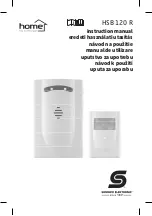
F-901B Reference Manual
Page
13
of
15
Calibration
All units are shipped factory‐calibrated. Over
time all sensors require recalibration to ensure accuracy. There are
several options for calibration:
•
You can ship your F-901B or individual sensor back to us for calibration
•
You can order pre-calibrated sensors from us to
•
You can calibrate the sensors yourself
The performance of a sensor or the whole instrument should be checked regularly with calibration gas. Replace sensor
when its sensitivity (span) is below 50 % of its initial value. The calibration interval depends on a number of factors
including application, environmental conditions, regulations and accuracy requirements.
User calibration
Follow the instructions in the Modbus
description to calibrate the F-901B sensors.
Sensor calibration typically involves a zero (baseline) and a span (sensitivity) calibration. Zero calibration commonly
uses “zero gas” such as 100% N2 while span calibrat
ion uses target gas for calibration. Below are recommended
calibration gases for the F-901B:
Sensor
Zero
Span
C2H4
100% N2 or
Fresh ambient air + KMnO4 filter
200ppm or 500ppm C2H4
CO2
100% N2 or
Fresh ambient air + Soda-lime filter
20% or 90% CO2
O2
100% N2
Fresh ambient air (20.9%) or
50% O2
Note:
•
When calibrating CO2 sensor, both zero and span calibration need to be performed (with zero calibration first).
On C2H4 and O2 sensor, zero calibration is not required during the calibration process.
•
If possible, calibrate the device with the gas sensor at conditions similar to the intended usage. Use a gas
mixture representing the gas matrix in the application then perform the span calibration with the target gas.
In some rare cases, the cross-sensitivity to a different gas can be used.
•
If you use pressurized gas bottle and pressure-controlled regulator, follow the setup below to properly applying
gas to the device.


































